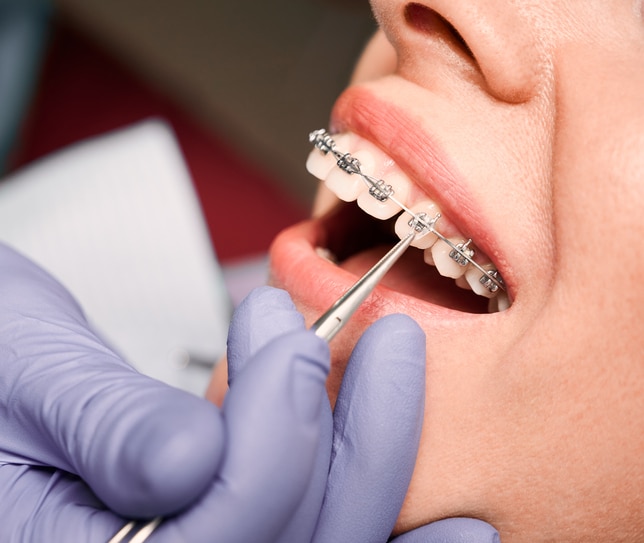Professional Cumming Braces and Aligners: What to Know Prior To You Go to
Professional Cumming Braces and Aligners: What to Know Prior To You Go to
Blog Article
Comprehensive Overview to Orthodontics Procedures for Correcting Dental Imbalances
In the world of orthodontics, the trip to attaining a flawlessly lined up smile entails a myriad of procedures tailored to fix dental imbalances. From standard braces to unnoticeable aligners and even surgical options, the area of orthodontics uses a variety of services to resolve varying levels of dental abnormalities. Comprehending the ins and outs of each treatment, including their systems, benefits, and potential downsides, is critical in making informed decisions about one's orthodontic treatment. As we browse with the detailed overview to orthodontic treatments for dealing with oral imbalances, the intricate information of each technique will certainly unfold, clarifying the path towards a harmonious and functional dental placement.
Orthodontic Procedures Introduction

Along with typical dental braces and clear aligners, orthodontists may likewise advise various other interventions like headgear, palatal expanders, or retainers to address particular placement issues (aligners). These procedures are customized per person's special needs and may involve a mix of therapies to achieve the desired outcomes. Regular adjustments and monitoring are essential components of orthodontic therapy to make sure progress is on track and to make any kind of necessary modifications in the process. By going through orthodontic treatments, patients can not only accomplish a straighter smile however additionally boost their overall oral wellness and feature.
Conventional Braces: Just How They Function
When taking into consideration orthodontic therapies for oral misalignments, standard dental braces stand out as a reliable approach for correcting teeth positioning. Typical dental braces consist of brackets, cables, and bands that function together to apply continual stress on the teeth, gradually relocating them right into the desired placement.
As pressure is used to the teeth through the braces, the bone surrounding the teeth is reshaped to support the new tooth settings. Individuals will require regular modifications at the orthodontist's workplace to guarantee the dental braces continue to apply the correct stress for efficient teeth movement.
Undetectable Aligners: Cons and pros
Invisible aligners offer a practical and very discreet choice to typical braces for dealing with dental imbalances. These clear, customized trays are virtually unseen when used, making them an attractive option for people seeking an extra cosmetically pleasing orthodontic treatment. Among the key benefits of invisible aligners is their removability, permitting much easier upkeep of oral hygiene contrasted to conventional dental braces. Clients can get rid of the aligners before consuming or brushing their teeth, decreasing the danger of food obtaining stuck in the appliance and simplifying the cleansing procedure.

Surgical Orthodontic Options
Surgical treatments in orthodontics present feasible choices for dealing with intricate oral misalignments that might not be successfully dealt with via traditional orthodontic therapies. While standard dental braces and unseen aligners can correct numerous orthodontic problems, specific situations require surgical intervention to accomplish ideal results. Surgical orthodontic choices are generally recommended for extreme malocclusions, significant jaw disparities, and situations where the underlying bone structure requires modification to achieve proper alignment.
One typical surgical orthodontic treatment is orthognathic surgical treatment, which involves repositioning the jaws to deal with functional problems such as problem talking or eating. This surgical treatment is typically done in collaboration with an orthodontist who assists straighten the teeth before and after the treatment. Surgical orthodontics might likewise entail procedures to expose impacted teeth, eliminate excess periodontal tissue, or improve the jawbone to create a more unified face profile.
Before thinking about surgical orthodontic options, clients undertake a comprehensive evaluation to figure out the necessity and potential benefits of such interventions. cumming invisalign. While surgical procedure might seem challenging, it can substantially improve both the function and aesthetic appeals of the smile in situations where standard orthodontic therapies fail
Retainers and Post-Treatment Treatment

Post-treatment care entails following the orthodontist's directions carefully. This may consist of appropriate oral health practices, going to follow-up appointments, and using the retainers as recommended. Failing to abide with post-treatment care guidelines can cause relapse, where the teeth gradually return towards their initial positions. Consistent retainer wear, good dental health, and regular oral check-ups are important for keeping the outcomes attained with orthodontic surgical treatment and guaranteeing the long-lasting security of the corrected dental alignment.
Final Thought
In verdict, orthodontic procedures offer numerous choices for correcting oral imbalances. Conventional dental braces use steel braces and cables to shift teeth right into proper placement. Unnoticeable aligners provide a more very discreet choice however might not appropriate for all instances. Surgical orthodontic choices are available for a lot more serious misalignments. Retainers are generally used post-treatment to preserve the brand-new alignment. Overall, orthodontic procedures can effectively improve dental wellness and visual appearance.
As we navigate with the comprehensive guide to orthodontic procedures for dealing with oral misalignments, the intricate details of each method will unravel, losing light on the path towards a harmonious and useful dental positioning. - cumming orthodontist
One of the most common orthodontic therapies is the usage of dental braces, which are composed of metal braces and wires that use gentle stress to gradually change teeth into the site web desired setting.When considering orthodontic treatments for dental imbalances, conventional braces stand out as a reliable technique for correcting teeth placing. Furthermore, unseen aligners might not be appropriate for intricate orthodontic concerns that need more substantial teeth movement, as they are typically advised for light to moderate situations. Retainers are tailor-made orthodontic devices developed to hold teeth in their corrected positions after the conclusion of orthodontic treatment.
Report this page